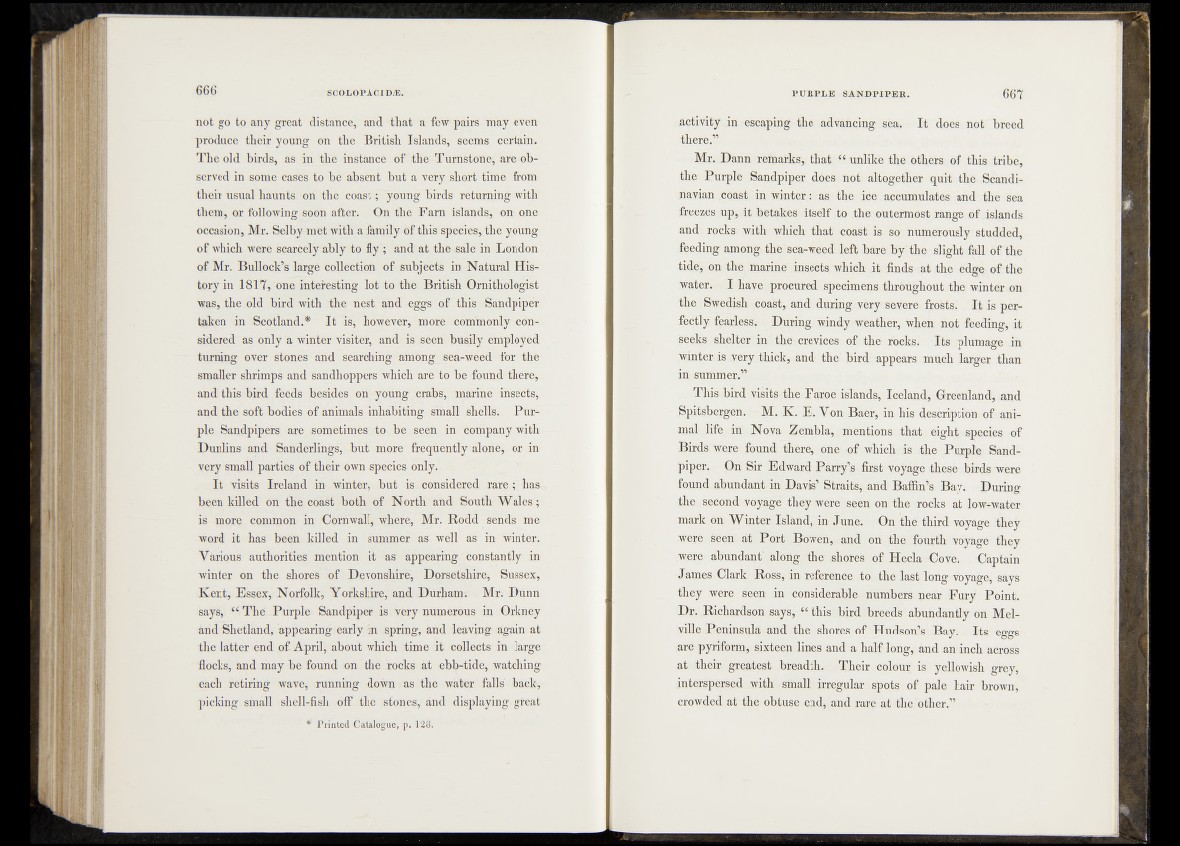
not go to any great distance, and that a few pairs may even
produce their young on the British Islands, seems certain.
The old birds, as in the instance of the Turnstone, are observed
in some cases to be absent but a very short time from
their usual haunts on the coast; young birds returning with
them, or following soon after. On the Fam islands, on one
occasion, Mr. Selby met with a family of this species, the young
of which were scarcely ably to fly; and at the-sale in London
of Mr. Bullock’s large collection of subjects in Natural History
in 1817, one interesting lot to the British Ornithologist
was, the old bird with the nest and eggs of this Sandpiper
taken in Scotland.* It is, however, more commonly considered
as only a winter visitër, and is seen busily employed
turning over stones and searching among sea-weed for the
smaller shrimps and sandhoppers which are to be found there,.
and this bird feeds besides on-young crabs, marine -insects,
and the soft bodies of animals inhabiting small shells. Purple
Sandpipers are sometimes to be seen in company with
Dunlins and Sanderlings, but more frequently alone, or in
very small parties of their own species only.
I t visits Ireland in winter, but is considered rare ; has.
been killed on the coast both of North and South Wales-;
is more common in Cornwall, where, Mr. Rodd sends me
word it has been killed in summer as well as in winter.
Various authorities mention it as appearing constantly in
winter on the shores of Devonshire, Dorsetshire, Sussex,
Kent, Essex, Norfolk, Yorkshire, and Durham; Mr. Dunn
says, ié- The Purple Sandpiper is very numerous in Orkney
and Shetland, appearing early in spring, and leaving again at
the latter end of. April, about which time it collects in large
flocks, and may be found on the rocks at ebb-tide, watching
each retiring wave* running down as the water falls' back,
picking small shell-fisli off the stones, and displaying great
* Printed Catalogue, p. 128.
.activity ,jri escaping the advancing sea. It does not breed
there.”
Mr. Dann remarks, that “ unlike the others of this tribe,
the Purple Sandpiper does not altogether quit the Scandinavian
.coast in winter : as the ic e , accumulates and thé sea
freezes ;up, it betakes itself to .the outermost .range, o f. islands
and, rocks with which that coast is;'SQ, numerously studded,
feeding among thé sea-weed, left bareby'the slight fall o f the
tide, on the marine insects, which .it finds .at the edge- of the
water, I f if e procured specimens throughout, thé. winter on
the ' Swedish ■ coast, and . during, very severe , frosts# I t is perfectly
fearless7’ During windy weather, when not feeding, it
£eeks shelter: in'the-crevices of the rocks; Its plumage in
winter is very thick, and-the'bird appears much larger .than
in summer.”
, This bird visits the Faroe islands, Iceland, Greenland, and
Spitsbergen. ;-"M. K. E. Von Baer, in his-'description of:.arii-
mal life in Noyai Zembla, mentions that eight species of
Birds were found there, which is the Purple Saridk
piper. On Sir Edward Parry’s first- voyage these ; birds were
found .abundant in Dayi$ Straits* and Baffin’s Bay^ii During
cthe .second voyàg^they were seen on the rocks at low-water
mark on Winter- Island, in J une. - On the third voyage they
wereuseen tftf, Port Bowen, and on the/fourth voyage'they
were abundant* along the shores- of Heck^OoVCf . Captain
• J ames Clark Ross, in reference to^Aim lust long-Voyage,-says
th i l l were kelfijÉ in considerable numbers near Fury Point.
Dr. .Richardson says* “ this bird breeds'abundantly on MeL
ylile Peninsula and the- shor'esfôf Hudson’s Bay. Its eggs-
are pyriform, sixteen lines and a half long, ànd an inch-across
at their greatest breadth. Their colour is yellowish grey,
interspersed, with small irregular spots of pale hair brownj
crowded at the obtuge^end/and rare at the'other&i§É§